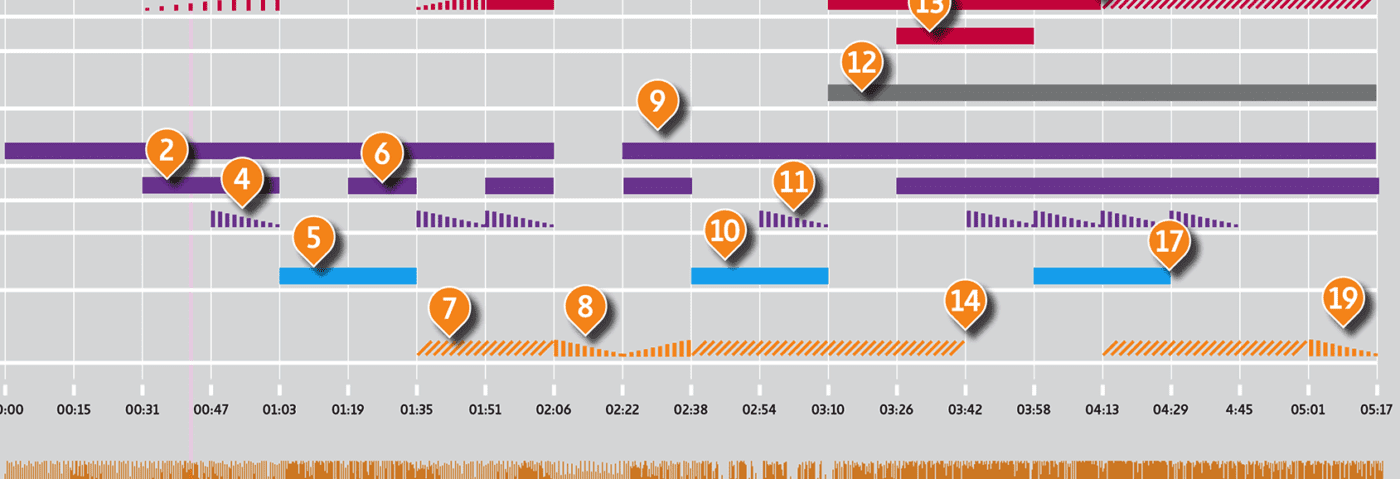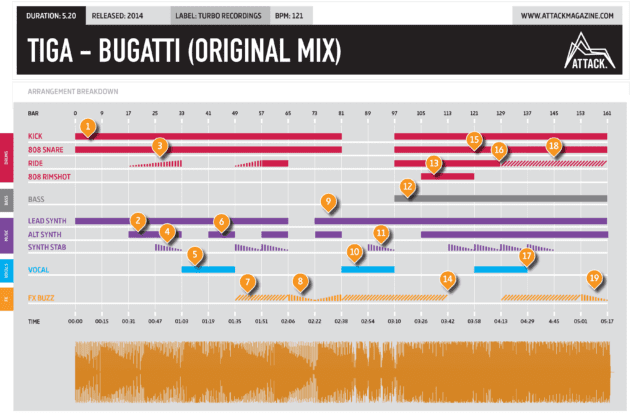By popular demand, we deconstruct the arrangements of a series of tracks to see what we can learn from their structure. We start with one of the biggest tracks of 2014.
To kick off this series, we look at Tiga’s deceptively simple ‘Bugatti’, an exercise in structural simplicity that makes a small handful of mix elements do a lot of heavy lifting.
The track
The arrangement
Click to enlarge.
What’s happening?
1. ‘Bugatti”s DJ-friendly lead-in comprises 16 bars of the track’s simple kick and 808 snare pattern, supporting the defining lead synth hook that will play throughout most of the track. It’s worth noting the amount of low-end bass content in the kick drum. This is important as the bassline proper doesn’t enter the mix until after the three-minute mark, meaning the kick drum is the main instrument in the extreme low registers.
2. After 16 bars, a second synth line – riffing off the original – enters the mix. Note that it doesn’t actually enter on the beat, but just before. This is a key feature of the arrangement of the track, with Tiga using repeated instances of anacrusis to subtly lead into new sections. It’s a neat audio trick that is one of several arrangement flourishes in what is otherwise a generally simple structure.
The bassline doesn't enter the track until after the three-minute mark
3. During this section, a third beat element increases in volume: a ride that sounds like a layered mix of sustained live hit and white noise. Two things are apparent from the off: it is mixed low, just filling the gaps between kick and snare, and much of its high end has been rolled away, so it doesn’t interfere with the two synth hooks. It will stay in the background for most of the track.
4. First instance of the recurring sustained siren/synth stab: a straightforward but effective piece of ear candy.
5. Just over a minute into the mix, the ride stops its gradual volume increase and is dropped from the mix to make way for the vocals, set against the same kick/snare/synth hook combo that opened the track. Again, note the use of anacrusis, with the word ‘Girl’ sounding before the first beat of bar 33.
6. Repeating the structural change at bar 17, the second motif is added.
7. A second instance of the siren/synth stab is layered with a new element: a dirty, fuzzy FX buzz that provides an ever-changing murk in the mix’s lower-mids. Automation of its filter cutoff gives tonal movement to the whole of the bar 49-65 section.
Automation of the filter cutoff gives tonal movement to the whole of the section
8. In the first of two mini breakdowns in ‘Bugatti’, the ride and both synth lines are dropped from the mix, leaving the kick and snare alone with the buzz – whose cutoff filter closes down completely approaching bar 73.
9. After the buzz fade-out, the synth leads re-enter the mix against the kick/snare backbone… and then shortly afterwards the buzz filter is automated open again to rise back into the mix. This filter rise/fall is a classic arrangement trick for taking down the tension before ratcheting it up again: ideal for the dancefloor.
10. The vocal returns, this time against the murky background of the now fully filter-opened buzz but, crucially, with no drums at all for the first time in the mix, marking the start of a second quasi-breakdown.
11. The siren stab gives added FX support to a second instance of the vocals.
12. The beat returns, supporting the new-to-arrangement bassline. Like the rest of the sounds, it’s simple but brutally effective: a three-note acid-style motif mixed loud and proud at the front of the mix.
13. It’s all happening now. Just 8 bars after the bassline is introduced, a second new instrument hits the mix: a flighty 808 rimshot groove. The second synth riff is also re-introduced.
14. When the buzz leaves the mix its previous contribution becomes obvious: suddenly there’s a lot less going on, particularly in the lower mids. A siren stab helps ease the transition.
15. Tiga’s arrangement isn’t full of wild fills. Indeed, here’s the only time he resorts to any kind of rhythmic turnaround: a full-mix reverse leading into bar 121 and the return of the vocals.
16. Through this section, the level of the previously low-level ride cymbal is increased to put it centre stage. The return of the buzz at bar 129 brings all main mix elements in for the first and only time in the track. Automation of the buzz filter cutoff continues, opening and closing it subtly over time to keep the ears – and dancefloor – engaged.
Tiga's arrangement isn't full of wild fills. Here's the only time he resorts to any kind of rhythmic turnaround
17. The vocals finish, leaving all key musical and beat elements in. The ride cymbal continues to dominate the drum track.
18. Check the elegantly executed ramp up in pitch of the now dominant ride at bar 145, preceded by a wobbly descent, bringing further gentle attention to what is now the most important element in the mix.
19. The buzz’s filter cutoff closes down as the track approaches its end. At the same time, the ride cymbal’s playful messing continues during the final 8-bar section, its pitch automated slowly down and then its attack and decay envelopes getting a final tweak in the last four bars.


03.25 PM
Yeah Im a big fan of deconstructed arrangements. I have a natural flow with my own which is difficult to break out of so this kind of article is welcomed. Lots and lots more of these please.
06.20 PM
I’d also love more of these!
09.30 PM
Love the visual layout of the arrangement!!!! Wish all these articles had this!
09.34 PM
Fantastic article.. arrangement is what I struggle with the most so these kinds of breakdowns are super helpful to understand what I can work on. I like tracks like these that aren’t virtuosic but are musical and do a lot with a little.
11.29 AM
Deconstructing one of Levon Vincent tracks would be quite a challenge and interesting read of course.
11.53 AM
how did you produce the infographic of the arrangement ? is there a specific tool you use ?
12.34 PM
Splice
01.37 PM
@p – I used In Design. Across about five hours! Thanks @Neo for the suggestion. Any other suggestions always gratefully received.
07.31 PM
Yep, more of these please!
09.02 PM
Great article and infographic!
Always like reading Attack Magazine.
02.24 AM
This site needs more of this.
09.29 PM
Loved reading it with a wonderful infographic; attackmag needs at least one article per week like this one. I still don’t get the song tho! Why the success? Why the fuss? Why the interest of the others into this dull matter? I was always caught by simplicity (ie. Recondite – Levo) but come on… tedious Bugatti does not deserve that attention.
08.05 AM
Thanks for the great article! Definitely learned some new things from it.
Just made a remix for “Bugatti”: https://soundcloud.com/edge_67/tiga-bugatti-edge-67 , check it out!
11.01 AM
The arrangement graphic is awesome.
Wish you turn this into a web app and catalog more tracks.
11.23 AM
It’s a great idea BTW. I’m ready to help with the ‘coding’ part of the work 🙂
12.37 AM
+1 to Levon Vincent. Or some Livity Sound stuff. These are great, thank you.
06.32 PM
Great to see another deconstructed article. For me though, a horrible song choice. Love to see more Four Tet/Floating Points/Bonobo type of stuff up here. Cheers dudes.
04.20 PM
Love it!!!
06.46 AM
I love it also 🙂
04.55 PM
Very cool article and interesting approach of a deconstruction, keep it on
04.12 AM
absolutely killer article. great graphic and great choice of a track – brutally simple. tracks with varying/increasing complexity for the next features would probably be good. this kind of analysis is really helpful. I also read this one with a a different, but similar graphical approach, too: http://www.ethanhein.com/wp/2013/analyzing-the-musical-structure-of-sledgehammer-by-peter-gabriel/
many thanks, mr felton.
03.20 AM
i really need more of this , congrats attack ! love it
02.46 PM
this sustained siren/synth stab – just few weeks ago randomly found a presets in one of the d16’s fx plugin that make this kind of buzzing and now completly forgot!!!
great for this kind of stabs with lfo to pitch (osc) modulation.